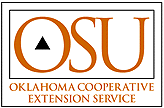
Forage Crops
Production Technology
DEPARTMENT OF PLANT &
SOIL SCIENCES
DIVISION OF AGRICULTURAL SCIENCES & NATURAL RESOURCES
OKLAHOMA STATE UNIVERSITY

August 2002
ALFALFA VARIETIES FOR OKLAHOMA - 2002
John Caddel
Forage Extension Agronomist
Jay Prater
Senior Agriculturist
To assist producers with decisions related to variety choices, personnel in the Plant and Soil Sciences Department through the Oklahoma Agricultural Experiment Station, Cooperative Extension Service, and OSU conduct alfalfa variety
valuations in Oklahoma. Normally 10-20 new alfalfas are submitted annually for testing in Oklahoma.The table below summarizes data collected for many years (through plantings in 2000). For those who want detailed information about alfalfa variety performance in Oklahoma, results are always on the Internet at http://alfalfa.okstate.edu/var-test/alf-var.html. Currently, detailed results for the years 1998-2001 may be seen and printed from that site. If you would like to study older data, contact - john.caddel@okstate.edu.
| Table 1. Performance summary of the proven varieties | ||||||
| Variety | Relative Yield | Number of Test-Years | Total Number of Tests | Higher than Average | Higher than Average | Highest in Test |
| (%) | (no. of tests) | (% of tests) | (no. of times) | |||
| Good as Gold II | 105.8 | 21 | 7 | 7 | 100 | 6 |
| Magnum V | 103.8 | 17 | 7 | 7 | 100 | 1 |
| Reward | 103.5 | 30 | 11 | 11 | 100 | 2 |
| Enhancer | 102.9 | 22 | 8 | 8 | 100 | 0 |
| Garst 6420 | 102.2 | 14 | 8 | 6 | 75 | 1 |
| OK 49 | 102.3 | 100+ | 39 | 28 | 72 | 7 |
| Innovator+Z | 102.2 | 21 | 7 | 3 | 43 | 1 |
| Key | 101.4 | 14 | 5 | 3 | 60 | 1 |
| Magnum IV | 101.3 | 23 | 10 | 7 | 70 | 0 |
| Garst 630 | 101.1 | 100+ | 35 | 23 | 66 | 2 |
| Garst 631 | 100.8 | 30 | 13 | 8 | 62 | 1 |
| Cimarron 3i | 100.1 | 31 | 9 | 5 | 56 | 0 |
The varieties in Table 1 are well-tested. That is, they have been in several tests, representing most of the diverse alfalfa production areas in the state. The more a variety is tested, the more confidence we have in its performance. When varieties are tested as much as OK 49 and Garst 630 (included as checks in many tests), there will be some failures. There may be other good varieties marketed in Oklahoma, but they have not been tested (for whatever reason) or have been in only one or two tests. This is not good enough for us to "recommend" a variety.
|
Table 2. Varieties that show promise. |
||||||
|
Variety |
Relative Yield |
Number of Test-Years |
Total Number of Tests |
Higher than Average |
Higher than Average |
Highest in Test |
|
(%) |
(no. of tests) |
(% of tests) |
(no. of times) |
|||
|
Affinity+Z |
101.4 |
10 |
4 |
3 |
75 |
0 |
|
55H55 |
100.9 |
12 |
6 |
3 |
50 |
1 |
|
Depend+EV |
100.7 |
15 |
5 |
2 |
40 |
1 |
|
HayGrazer |
100.4 |
21 |
7 |
3 |
43 |
1 |
|
Cimarron SR |
100.4 |
11 |
5 |
3 |
60 |
0 |
|
Dagger+EV |
100.1 |
13 |
7 |
3 |
43 |
0 |
Most of the varieties in Table 2 have not been adequately tested to be considered for the "recommended" list. A Relative Yield score of 100% means that a variety’s yield performance is average among those tested. Generally, very few "bad" varieties are entered into our tests.
|
Table 3. Performance Summary of Buffalo and Oklahoma Common |
||||||
|
Variety |
Relative Yield |
Number of Test-Years |
Total Number of Tests |
Higher than Average |
Higher than Average |
Highest in Test |
|
(%) |
(no. of tests) |
(% of tests) |
(no. of times) |
|||
|
Buffalo |
98.0 |
100+ |
32 |
10 |
31 |
1 |
|
OK08 |
92.1 |
100+ |
68 |
5 |
7 |
1 |
Table 3 includes yield performance of the old varieties, Buffalo and OK08. Many variety performance tests include an "Oklahoma Common" (usually represented by OK080 and/or Buffalo). These are frequently the lowest yielding varieties and rarely higher than average. Note: When these are included in variety tests, we clean the seed so its seed quality is comparable to other entries. Normally this means removing a high percentage of small shriveled seed, sometimes a high percent foreign material, and weed seeds. The "Oklahoma common" seed that is available from many seed stores may be almost anything. Usually it is not as good as a recommended variety.
|
Seed of Good Varieties is Expensive To reduce establishment costs , try:
|
| Additional Information: Alfalfa forage yield for a particular variety varies from year to year and from one site to another; however, a variety's Forage Yield Score varies much less. For this reason (and to conserve space), Forage Yield Scores are presented. This is the total yield for a variety in a test divided by the average of all varieties in the test multiplied by 100. Detailed yield data for each harvest in every trial are available from the authors for interested readers. |
The information given herein is for educational purposes only. Reference made to commercial products or trade names is with the understanding that no discrimination is intended and no endorsement is implied. Oklahoma State University does not discriminate on the basis of race, color, national origin, sex, age, religion, disability, or status as a veteran in any of its policies, practices or procedures. Issued in furtherance of Cooperative Extension work, acts of May 8 and June 30, 1914, in cooperation with the U.S. Department of Agriculture, Sam E. Curl, Director of Oklahoma Cooperative Extension Service, Oklahoma State University, Stillwater, Oklahoma. This publication is printed and issued by Oklahoma State University as authorized by the Dean of the Division of Agricultural Sciences and Natural Resources.
Page 2
August 2002